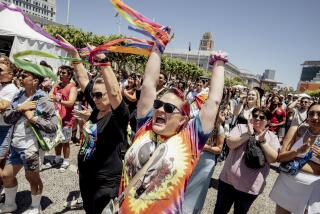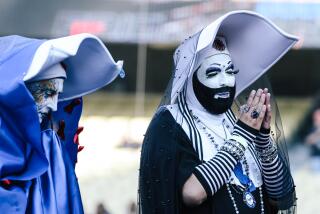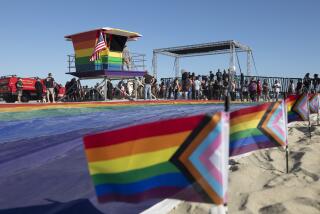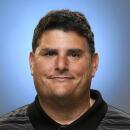From gay bashing to AIDS to same-sex marriage, L.A. pride parade reflects hopes, dreams and despairs
The pride parade in West Hollywood has served as a spectacle, talent show, celebration, political movement and memorial.
But over a half-century, it has also helped chronicle the LGBTQ community in Southern California. Once each decade — including today — the parade commemorates the Stonewall uprising.
Here is a look back through the pages of The Times:
1970: Fighting for the right to march
The first pride parade in Los Angeles came with great controversy, including a legal battle and threats of violence.
According to a Times story, the Los Angeles Police Commission predicted violence and demanded the organizers submit a $1,500 cash bond. A judge, however, rejected that requirement, citing constitutional guarantees of free expression. (Read about the legal battle).
There was no violence, just some boos from a few hundred demonstrators on Hollywood Boulevard.
L.A. gay rights pioneer Morris Kight told The Times in 1988 that he and others organized a gay pride parade to commemorate the Stonewall riot in New York, a pivotal moment in the gay rights movement.
TIMELINE: L.A. pride through the years
Police Chief Ed Davis was among those who thought the parade was a bad idea, arguing that “it would be just as responsible to let thieves and robbers have a parade,” said Jim Kepner, longtime gay activist and founder of the International Gay and Lesbian Archives.
And in any case, “it would cost a lot of money and blood to protect us, which they didn’t want to do.”
Actually, Davis was right about one thing: On the morning of the parade, Kight says he received eight separate death threats. “One of them said, ‘Is it OK if I kill you?’” he recalled
“’Oh, not today,’ I said. ‘I’m very busy today. I have to put on a parade. Tomorrow would be much better. How about Monday? Tuesday. Call Wednesday. Ta-ta.’”
Kight died in 2003.
1979: A move west
The parade was held in Hollywood through most of the 1970s.
But in 1979, it moved to West Hollywood, which had a large and growing gay population.
The move further established West Hollywood as a center of L.A. gay life. In 1984, the unincorporated community won cityhood.
1989: AIDS and love
An estimated 200,000 attended the 1989 parade, which took place during the height of the AIDS epidemic and included counterprotesters from a Christian fundamentalist group.
“When this generation started, it was not gay to be gay. We are celebrating 20 years of action. I find it stunning,” said Kight.
The theme of the celebration, which capped a two-day street festival, was “Stonewall 20: A Generation of Pride.” The festival marked the 20th anniversary of the 1969 rebellion at the Stonewall Inn, a gay bar on Christopher Street in New York. The event is regarded in the homosexual community as the turning point in the modern gay and lesbian rights movement.
“I think it’s a great day, I feel good I am still here,” said Paul Duncan, who was undergoing treatment for AIDS. “To me, the parade is a celebration of pride, a day I don’t have to worry about AIDS.”
Veteran CARES, a group of gay veterans representing all branches of the military, led 257 floats and marching groups in the pageant. The parade was sponsored by Christopher Street West/Los Angeles, a nonprofit group that provides grants to the gay and lesbian community.
The 10,000 marchers, ranging from the elegant to the extraordinary, waved and shouted to those who jammed the sidewalks. Assemblywoman Maxine Waters (D-Los Angeles), the parade’s grand marshal, and Los Angeles Mayor Tom Bradley received warm ovations as they rode in vintage Cadillacs.
A character called “Kaptain Condom,” dressed in a red-white-and-blue superhero suit, also was cheered as he cruised by the grandstand on an old military tank decorated with balloons and streamers. Not far behind were the West Hollywood High Cheerleaders, a group of female impersonators sporting pompoms, false breasts, wigs and mustaches.
“This is our day to be free,” said Steve Pounds, 29, who had been attending the parade with his mother for 10 years. “It is about time we can be ourselves.”
Pounds’ mother, JoAnne Wright, was equally enthusiastic.
“I don’t believe gays belong pushed in the closet,” Wright said. “The parade is a very positive thing — I think more parents should support their children.”
Not everyone at the parade shared that view.
A knot of Christian fundamentalist protesters, largely ignored by the crowd, stood to one side. “Shame on you for what you do,” they chanted.
1999: Booming but unequal
In 1999, The Times looked at how West Hollywood — known as America’s first “gay city” — was doing 15 years after cityhood.
On a nighttime drive through the heart of his municipality, Mayor John Heilman took note of the winds of prosperity that have swept over West Hollywood since its dramatic birth in 1984.
“Hotels are booming and the range of entertainment is expanding,” Heilman said as he wheeled down the Sunset Strip. “Things have changed for the better. We are so fortunate and blessed. When we first became a city, it was pretty dead.”
The famed 1.9-square-mile slice of cityhood — sandwiched between Beverly Hills and Hollywood — has always been popular, but its fortunes really began skyrocketing about five years ago as a slew of fancy eateries, spruced-up luxury hotels and swank night spots began making money hand over fist.
Fifteen years ago, West Hollywood residents voted to make their unincorporated niche the 84th city in Los Angeles County, a move that was heralded worldwide as creating “A Gay Camelot” — the first openly gay-run city in the nation. The mayor and the majority of the City Council members were homosexual, as were a third of the city’s residents.
The politics of sexual orientation seem to catch the public’s eye, even though the desire for strict rent controls is what galvanized the voters to push for local control in this wildly diverse, renter-dominated city of 37,000.
Today, as West Hollywood celebrates its 15th anniversary, the city has matured. Its budget has more than doubled since its founding to nearly $36 million, including $2.8 million for social service programs — more per capita, city officials say, than any other city in the country.
But West Hollywood, like most urban pockets, also has special needs, particularly among the elderly, who make up 19% of the population, and among Russian immigrants, who account for an additional 10% to 15%. In addition, West Hollywood has the highest per capita rate of people living with AIDS of any city in Los Angeles County.
“There are those who can afford Starbucks coffee, and there are those who face a different kind of existence,” said Heilman, a civil rights attorney who is one of three gay men on the five-member City Council. “We have people on waiting lists for affordable housing who are forced to spend 50% of their income on rent.”
2009: The dark cloud of gay marriage fight
This pride parade occurred during a dark moment for many in the LGBTQ community. California voters the year before had approved Proposition 8, the ballot measure that barred same-sex marriage in the state. And President Obama had moved to defend a federal law restricting same-sex marriage.
“I think it’s a big mistake,” San Francisco Mayor Gavin Newsom said of Obama’s action shortly before he and his Los Angeles counterpart, Antonio Villaraigosa, kicked off the annual L.A. Pride parade in West Hollywood.
But their mutual disapproval of a Justice Department brief filed in support of the Defense of Marriage Act came amid growing discontent with Obama among gay rights groups.
The battle over same-sex marriage added a serious note to the West Hollywood celebration of the 40th anniversary of the Stonewall riots.
“I’m concerned about some of the arguments being made by the Justice Department,” Villaraigosa told a cluster of news crews on Santa Monica Boulevard as motorcyclists in the “Dykes on Bikes” group revved their engines for the parade’s start.
Rea Carey, executive director of the National Gay and Lesbian Task Force Action Fund, called the administration’s defense of the law unacceptable.
The Defense of Marriage Act “is and has always been an immoral attack on same-sex couples, our families and our fundamental humanity,” Carey said.
Other groups denouncing the brief included the Human Rights Campaign, Lambda Legal and the American Civil Liberties Union.
White House spokesman Shin Inouye said the Justice Department, in submitting the brief, was following its normal practice of defending a law on the books in court. Obama, he said, “remains fully committed” to his proposals on gay rights.
Gay rights groups have called on Obama to act more quickly on the major ones, including abandonment of the military’s “don’t ask, don’t tell” policy that bars gays in the armed forces from disclosing their sexual orientation.
Rodney Scott, president of Christopher Street West, the parade’s chief sponsor, said he was “deeply saddened” that Obama’s administration was defending the marriage law.
“That’s not the president I voted for,” he said as thousands of people lining Santa Monica Boulevard cheered the procession of marchers and floats.
Obama would eventually support gay marriage and Proposition 8 was struck down.
More to Read
Sign up for Essential California
The most important California stories and recommendations in your inbox every morning.
You may occasionally receive promotional content from the Los Angeles Times.










